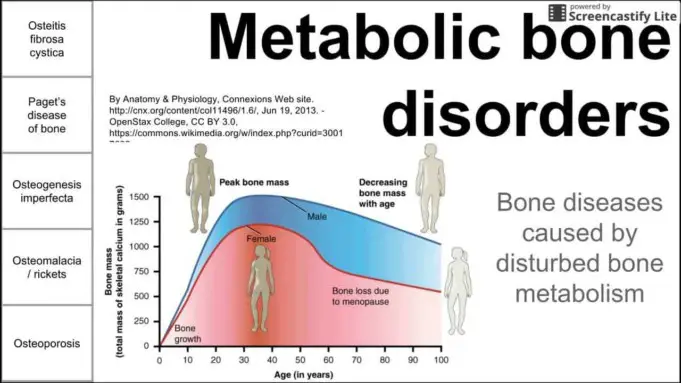Metabolic bone disease is a general term used to describe disorders affecting the bones and causing abnormalities.
These disorders occur as a result of the deficiency in certain vitamins and minerals such as calcium, phosphorus, magnesium and vitamin D.
The diseases are typically reversible once the underlying defect has been treated. Examples of metabolic bone diseases include marble bone disease, osteoporosis, osteomalacia, rickets, osteogenesis imperfecta, fibrous dysplasia and Paget disease of bone.
These bone disorders are different from genetic bone disorders which are caused by defects in cell type. However, metabolic bone diseases and genetic bone disorders may sometimes overlap. For instance, genetic hypophosphatemia may result in osteomalacia, a metabolic bone disease.
Bones are composed of proteins and minerals, and like many other tissues of the body, they undergo a continuous breakdown and renewal process. This bone resorption and formation process allows the skeleton to adjust to changes necessary for healthy functioning and maintaining optimum bone strength.
A healthy bone provides rigid support and is not brittle. The protein component called osteoid consists of collagen, a fibrous protein. While the mineral components are composed of calcium and phosphate crystals called hydroxyapatite.
Reduced bone density is used to measure the extent of damage caused by metabolic bone disease. Bone density can be measured by radiologic techniques in different bones.
The bones typically measured are bones in the hip, radius and the bones in the lumbar spine. The most common method used for measurement is the dual X-ray absorptiometry.
Bone density varies according to sex and genetic background. It also peaks around the age of 30. Bone density in men is higher than that of women. It is also higher in Black people than in Caucasians or Asians.
Types of Metabolic Bone Disease
Rickets
Rickets is a bone disorder that causes weak and soft bones in children as a result of a prolonged deficiency in Vitamin D. It can also be caused by genetic problems associated with the absorption of calcium and phosphorus, although that is rare.
Vitamin D is an essential nutrient that helps in the absorption of calcium and phosphorus from food. Inadequate supply of this vitamin can lead to rickets.
Symptoms of rickets include:
- Delayed motor skills
- Delayed growth
- Muscle weakness
- Pain in the spine, pelvis and legs
Marble Bone Disease
Marble bone disease is also known as Osteopetrosis, or Albers-Schönberg disease is a rare genetic condition that causes the bones to harden and become denser.
The disease progresses as the bones grow; the cavities of the marrow are filled with compact bone which results in a reduced amount of marrow which in turn reduces the bones capacity to produce red blood cells. This can lead to severe anemia.
Osteomalacia
This disease is defined by a marked softening of the bones and is commonly caused by lack of vitamin D. The softened bones in children and young adults with the disorder can lead to bowing, especially in bones that bear weight such as those in the legs.
Bone pain and muscle weakness are the common symptoms of osteomalacia, although the symptoms may not be noticed at first. The pain mostly affects the lower back, hips, legs, ribs and pelvis, and is rarely relieved by resting.
Treatment for the condition would involve the intake of vitamin D and calcium, both of which are required to strengthen bones.
Osteoporosis
This type of metabolic bone disease causes the bones to become so weak and brittle that even the smallest movement such as stretching, bending over or even cough, can cause a fracture. Fractures caused by osteoporosis commonly occur in the spine, wrist, or hip.
Symptoms of osteoporosis include:
- Back pain, caused by a fractured vertebra
- Bone that fractures easily
- Stooped posture
- Loss of height over time
Osteogenesis Imperfecta
Osteogenesis imperfecta also commonly referred to as brittle bone disease, is a condition that causes fragile bones that break easily. It is present at birth and develops in children with a family history of the disorder.
Osteogenesis imperfecta can result in a few bone fractures in mild cases. However, severe forms of the disease can lead to heart failure, hearing loss, spinal cord problems and deformities. The condition can be fatal if it occurs in babies before or shortly after birth.
Symptoms of the condition depend on the severity of the disease. They include:
- Weak dentition
- Loose joints
- Bluish color in the white of the eye
- Bone deformities
- Bowed legs and arms
- Multiple broken bones
- Heart defects
- Respiratory problems
- Hearing loss
- Scoliosis or curved spine
Fibrous Dysplasia
Fibrous dysplasia is a rare metabolic bone disease that results in scar-like tissue that develops in place of normal bone. This tissue can weaken the affected bone and cause it to deform or fracture.
The disease is a genetic disorder caused by a gene mutation that is not inheritable from parent to child. There is no cure for fibrous dysplasia – treatment options which may include surgery are for relieving pain and repairing bones.
Mild cases of the disease may cause few or no signs. Symptoms of more severe cases include:
- Mild to moderate pain in the bones
- Bone deformity
- Swelling
- Bowing of leg bones
- Bone fractures, especially in the arms or legs
Sources;
- Brief Review on Metabolic Bone Disease – NCBI
- Metabolic Bone Disease – Britannica
- Metabolic Bone Disease – Wikipedia
- Metabolic Bone Disease – Washington Endocrinology
- Brittle Bone Disease – Healthline
- Conditions We Treat: Metabolic Bone, Calcium and Parathyroid Disorders – John Hopkins Medicine












